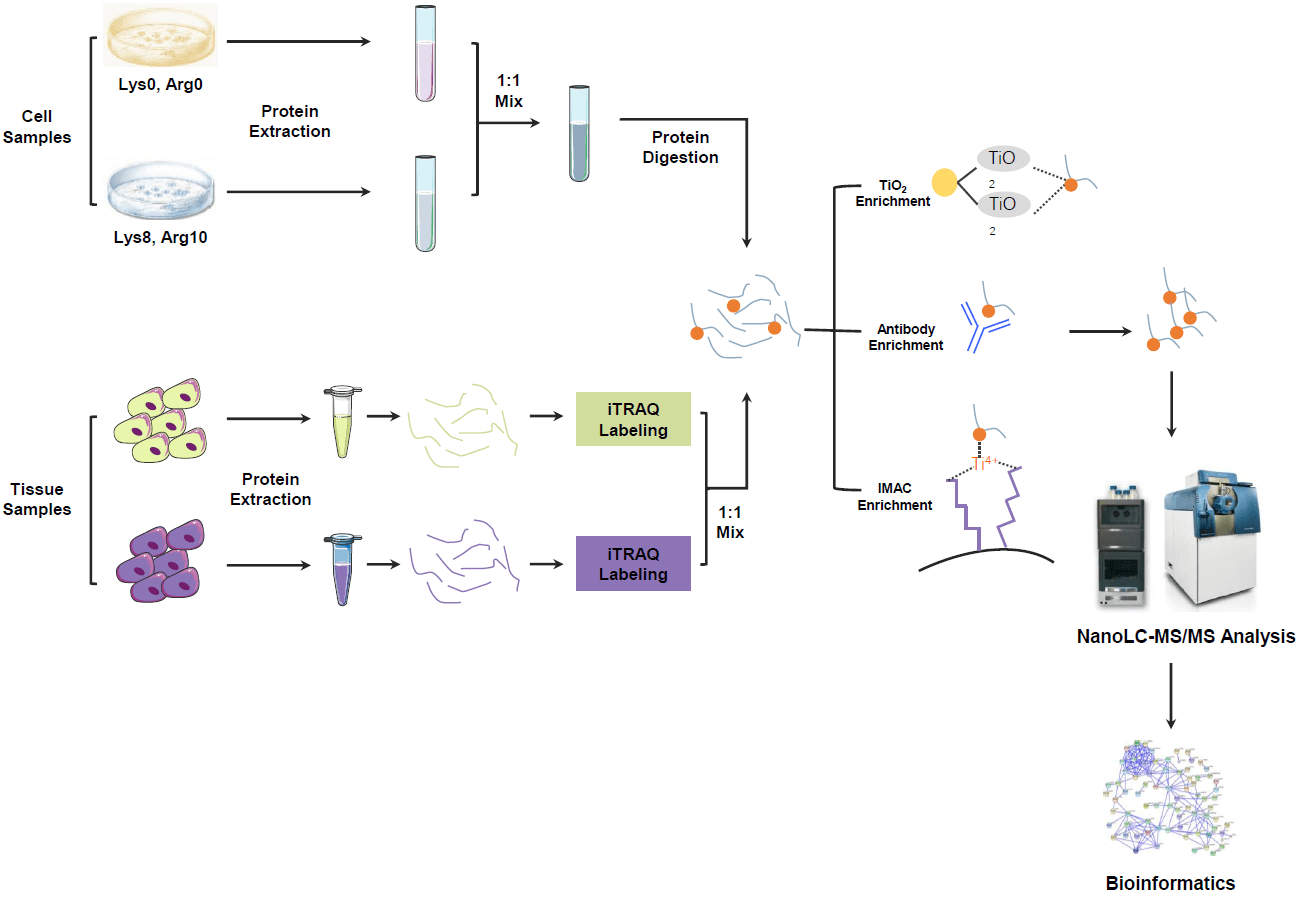Protein Phosphorylation Analysis Service
Based on advanced mass spectrometry platforms and efficient phosphopeptide enrichment techniques, MtoZ Biolabs has launched the protein phosphorylation analysis service which can systematically identify and quantitatively analyze phosphorylation sites in protein samples, revealing the site distribution, modification levels, and dynamic changes of phosphorylation modifications. The final output includes accurate identification results of phosphorylation sites, quantitative differential analysis, and related signaling pathway annotations, providing reliable evidence for researchers to study cellular signal regulation, disease mechanisms, and drug actions.
Overview
Protein phosphorylation refers to the process in which a phosphate group is introduced into specific sites of proteins through the action of kinases, and it is one of the most common and important post-translational modifications. The basic principle of protein phosphorylation analysis is to use mass spectrometry combined with enrichment strategies or phosphorylation-specific antibodies to identify and quantify phosphorylation sites in protein samples, thereby revealing their dynamic changes and functional regulatory mechanisms. This method can help researchers gain in-depth insights into the activation states of signaling pathways and key regulatory nodes, broadly regulating various biological processes such as signal transduction, metabolic regulation, and the cell cycle, and providing data support for further studies.

Figure 1. Schematic Diagram of Protein Phosphorylation.
Services at MtoZ Biolabs
1. Target Protein Phosphorylation Analysis
MtoZ Biolabs can perform site-specific or overall phosphorylation profiling for customer-designated target proteins, accurately identifying modification changes under different experimental conditions. Leveraging a high-resolution LC-MS/MS platform, we can reveal variation trends at key regulatory sites and provide reliable data support for protein function studies and mechanism validation.
2. Phosphoproteomics Analysis
MtoZ Biolabs integrates commonly used phosphorylation enrichment strategies such as IMAC and TiO₂ with high-throughput LC-MS/MS to systematically identify and quantify large numbers of phosphorylated peptides from complex samples. This service reveals global phosphorylation network features and supports pathway-level regulatory analysis, key node screening, and large-scale phosphoproteome mapping.
Analysis Workflow
1. Sample Preparation
Protein extraction and quantification of samples such as cells, tissues or body fluids to ensure uniform quality.
2. Protein Digestion
Proteins are digested into peptides to facilitate subsequent enrichment and detection of phosphorylation modifications.
3. Phosphopeptide Enrichment
Methods such as IMAC (immobilized metal ion affinity chromatography) or TiO₂ are used to selectively enrich phosphorylated peptides, improving detection sensitivity.
4. Mass Spectrometry Detection
The enriched phosphopeptides are analyzed using an LC-MS/MS platform for high-resolution identification and quantitative analysis, providing phosphorylation sites and modification levels.
5. Data Analysis
Database searches and bioinformatics tools are applied to annotate phosphorylation sites, outputting site distribution, differential levels, and signaling pathway analysis results.

Figure 2. The Experiment Workflow of Protein Phosphorylation.
Sample Submission Suggestions
1. Sample Type and Quantity

2. Sample Storage
Samples should be stored under low-temperature conditions (such as -80°C freezing) to avoid repeated freeze-thaw cycles, preventing protein degradation or the loss of phosphorylation modifications.
3. Sample Transportation
During transportation, samples should be shipped on dry ice or under cold-chain conditions to ensure integrity and the stability of phosphorylation modifications before reaching the analysis platform.
Service Advantages
1. High Sensitivity
With advanced LC-MS/MS platforms and optimized workflows, low-abundance phosphorylation sites can be accurately detected in complex samples, ensuring data reliability.
2. Specific Enrichment
Multiple enrichment strategies such as IMAC and TiO₂ are applied to effectively isolate phosphorylated peptides, improving signal-to-noise ratio and result accuracy.
3. Professional Team
Analyses are conducted and interpreted by experts with extensive experience in mass spectrometry and protein modification, ensuring standardized procedures and reliable data.
4. Customized Solutions
Detection depth and scope can be flexibly adjusted according to research needs, providing strategies tailored to diverse scientific and drug development objectives.
Applications
1. Signaling Pathway Research
The protein phosphorylation analysis service can be used to analyze the activation states and regulatory mechanisms of key intracellular signaling pathways, revealing the role of protein phosphorylation in cellular functions.
2. Disease Mechanism Exploration
By analyzing phosphorylation modifications of disease-related proteins, this service supports the study of molecular mechanisms in cancer, metabolic disorders, and neurological diseases.
3. Drug Target Validation
The protein phosphorylation analysis service can detect changes in protein phosphorylation levels after drug treatment, allowing the evaluation of drug effects on targets and downstream pathways.
4. Biomarker Discovery
Through systematic identification of phosphorylation sites, this service can uncover potential biomarkers associated with disease diagnosis or prognosis.
FAQ
Q1: Can Multiple Samples or Treatment Conditions Be Analyzed Simultaneously?
A1: Yes. This service supports parallel detection of multiple sample groups, facilitating comparisons of phosphorylation levels under different treatments or experimental conditions.
Q2: Can Low-Abundance Phosphorylated Proteins Be Detected?
A2: Yes. By combining IMAC or TiO₂ enrichment techniques with high-resolution LC-MS/MS platforms, low-abundance phosphorylated peptides can be detected.
Q3: What Advantages Does This Have Compared with Western Blot?
A3: Mass spectrometry enables systematic analysis of tens of thousands of phosphorylation sites on a global scale, offering broader coverage and higher accuracy than the single-target detection of Western blot.







